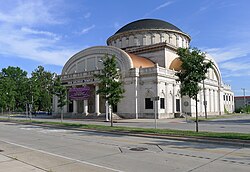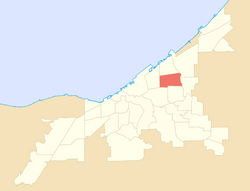Hough (pronounced /hʌf/) is a neighborhood situated on the East Side of Cleveland, Ohio.[2] Roughly two square miles, the neighborhood is bounded to Superior and Euclid Avenue between East 55th and East 105th streets.[2] Placed between Downtown Cleveland and University Circle, Hough borders Fairfax and Cedar–Central to the South and Glenville and St. Clair–Superior to the North.[3] The neighborhood became a target for revitalization during the mid-20th century, after the 1966 Hough Riots.[4]
Hough | |
|---|---|
 True Holiness Temple on Euclid Avenue, located on the border between Hough and Fairfax neighborhoods. | |
 Location in the city of Cleveland | |
| Country | United States |
| State | Ohio |
| County | Cuyahoga County |
| City | Cleveland |
| Population | |
• Total | 10,755 |
| Demographics | |
| • White | 7.6% |
| • Black | 88.4% |
| • Hispanic (of any race) | 2% |
| • Asian and Pacific Islander | 1.5% |
| • Mixed and Other | 2.5% |
| Time zone | UTC-5 (EST) |
| • Summer (DST) | UTC-4 (EDT) |
| ZIP Codes | parts of 44106, 44103 |
| Area code | 216 |
| Median income[1] | $19,003 |
| Source: 2020 U.S. Census, Cleveland City Planning Commission | |
History
editEarly history
editHough is one of Cleveland's oldest neighborhoods, named after Oliver and Eliza Hough, who first settled in the area in 1799.[5] The neighborhood was incorporated into the city of Cleveland in 1873.[6] At the start of the twentieth century, Hough was a community for primarily affluent white residents.[6] Prominent local families, such as the Severances and the Boltons, lived in Hough at this time, rivaling Millionaire's Row on Euclid Avenue.[7] Business sprung up around this period, including the Warner & Swasey Company in 1881.[7] Other commercial institutions included the Doan's Corner Shopping District on East 105th and Hough Bakery (later Hough Bakeries Inc.) near East 87th Street on Hough Avenue.[8][9]
After the First World War, this population dwindled, leaving an ethnic European working-class majority.[6] Hough then lost prominent institutions within the community, including University School and League Park, the latter of which being the original home of the Cleveland Indians.[2] University School moved out to Shaker Heights, and the Indians slowly moved out to Cleveland Municipal Stadium in Downtown.[2][10]
The Great Depression exacerbated Hough's neighborhood deterioration, including a lack of dwelling space amidst population growth, conversion of single-family homes into multi-family homes, and a decrease in home ownership.[8] During Prohibition, the area between Lexington and Hough Avenues between East 73rd and East 79th Streets was known as "Little Hollywood" for the large number of brothels and speakeasies located there.[11]
Transition to an African American community
editBy 1960, multiple factors ultimately coalesced into Hough becoming a poor, majority African American community. The Second Great Migration and slum clearance in Cedar-Central created a mass influx of Black people into Hough.[4] This was exacerbated by other city planning projects aimed with clearing blight, including freeway construction through communities like Central and Downtown Cleveland.[12] From 1957 to 1962, the city's University-Euclid urban renewal project demolished houses in Eastern Hough without creating enough new homes to compensate.[12] A lack of a properly enforced housing code led Hough to become extremely overcrowded, as landlords continued to create multi-family housing out of large single-family homes.[5] Blockbusting as a result of the increase in African Americans led to panic selling and white flight to the suburbs.[8]
The massive population boom weighed on the school system, leading to the city to not only create two half day groups to attend schools but also to introduce busing to white neighborhoods like Murray Hill.[13] The latter was a controversial practice that led to racial violence against Black students from Hough and Glenville.[13]
In 1966, just months before the Hough Riots, the Cleveland Press described Hough as a “powder keg,” citing racial tensions akin to the Watts Uprising in Los Angeles during the previous summer.[5] The neighborhood received national attention as a flashpoint of racial tension, when protest occurred for five days, or from July 18th to July 23rd.[6]
Revitalization efforts
editStokes administration
editThe Hough Area Development Corporation (HADC) was founded by civil rights activist Reverend Deforest Brown in the wake of the 1966 uprising, using Cleveland: NOW! money from Carl Stokes' administration to fund housing and jobs in Hough.[14][15] This included Martin Luther King Jr. Plaza, which was a mixed-use building that included housing and retail.[14] The HADC additionally provided opportunities for a broader coalition of Black business in the community, including job training.[15] Both the HADC and the Black nationalist group Operation Black Unity successfully created Black-owned McDonald's franchises through a 1969 boycott.[15] Although the franchises bought by the HADC failed to make enough money by the mid-1970s, the effort was highly influential on inner-city McDonald's and Black ownership in said communities.[15]
Stokes additionally worked with another Black nationalist group called Cleveland Pride in 1968 to plant sod as a symbolic means of making the neighborhood more attractive and hospitable.[5]
21st century
editHough has seen an increase of redevelopment, although it remains among the city's poorest neighborhoods.[16] This includes the 2014 preservation of League Park, a $6.3 million effort that renovated the original diamond into an AstroTurf field and turned its ticket office into a Baseball Heritage Museum.[17]
Today, Hough forms part of the city's 7th Ward and is represented by Councilwoman Stephanie Howse.[18]
Notable landmarks
editHough is home to some historical places, which include:
- Crawford-Tilden Apartments on East 84th Street and Crawford, on the southwest corner. Built in 1908, the apartments are in the National Register of Historic Places and are a Cleveland Designated Landmark.[19][20]
- League Park on East 66th Street and Lexington Avenue, the original ballpark of the Cleveland Spiders/Indians and the Negro League's Cleveland Buckeyes.[21] While much of the stadium was demolished in the 1950s, the diamond is now a part of a public park.[21]
- The East 89th Street Historic District is a small residential sect between Chester and Hough Avenue and is home to colonial revival housing indicative of the affluent residents that lived in Hough at the turn of the century.[22]
- The Charles F. Schweinfurth Residence close to the corner of Chester and East 75th Street was the home of the prominent Cleveland architect.[22] Originally built for a member of the Vanderbilt family, the structure resembles a castle.[23] After Schweinfurth's death, the house became a funeral home from 1930 to 1970, where it was then bought out and preserved in a larger 1970s attempt to revitalize the area.[23]
| Census | Pop. | Note | %± |
|---|---|---|---|
| 1940 | 64,800 | — | |
| 1950 | 65,694 | 1.4% | |
| 1960 | 71,575 | 9.0% | |
| 1970 | 45,487 | −36.4% | |
| 1980 | 25,330 | −44.3% | |
| 1990 | 19,715 | −22.2% | |
| 2000 | 16,359 | −17.0% | |
| 2010 | 11,475 | −29.9% | |
| 2020 | 10,755 | −6.3% | |
| Sources:[24][25][1] | |||
References
edit- ^ a b c "Cleveland Neighborhoods and Wards: Hough Neighborhood Factsheet (2021)" (PDF). The Center for Community Solutions (Cleveland). Retrieved June 3, 2022.
- ^ a b c d "Hough". Encyclopedia of Cleveland History | Case Western Reserve University. 2022-03-12. Retrieved 2022-07-13.
- ^ "Map of Hough, Implemented by the City of Cleveland in 2012" (PDF). Northern Ohio Data and Information Service (NODIS), Levin College of Urban Affairs (Cleveland State University). Retrieved August 5, 2022.
- ^ a b Keating, William Dennis (1999). Rebuilding urban neighborhoods: achievements, opportunities, and limits. Sage Publ. ISBN 0-7619-0691-6. OCLC 245986023.
- ^ a b c d Souther, Jonathan Mark (2017). Believing in Cleveland: managing decline in the "best location in the nation. Temple University Press. OCLC 1273187802.
- ^ a b c d "Hough". Cleveland Historical. July 20, 2016. Retrieved April 4, 2017.
- ^ a b "The History of Hough (1799-1979) Historical Marker". www.hmdb.org. Retrieved 2022-08-04.
- ^ a b c Campbell, Thomas F.; Miggins, Edward M. Guide to Studying Neighborhoods and Resources on Cleveland.
- ^ "HOUGH BAKERIES, INC". Encyclopedia of Cleveland History | Case Western Reserve University. 2019-04-02. Retrieved 2022-08-02.
- ^ "University School". Encyclopedia of Cleveland History | Case Western Reserve University. 2019-05-31. Retrieved 2022-07-13.
- ^ Cleveland City Planning Commission (1991). Civic Vision 2000 Citywide Plan (PDF) (Report). Cleveland, Ohio. p. 92. Retrieved August 25, 2018.
- ^ a b Hanson, Paul W. (2014-03-05). "Cleveland's Hough riots of 1966: ghettoisation and egalitarian (re)inscription". Space and Polity. 18 (2): 153–167. doi:10.1080/13562576.2013.879773. ISSN 1356-2576. S2CID 144791342.
- ^ a b Robenalt, James D. (2018). Ballots and bullets : Black Power politics and urban guerrilla warfare in 1968 Cleveland. Chicago, Illinois. ISBN 978-0-89733-704-5. OCLC 1019841488.
{{cite book}}: CS1 maint: location missing publisher (link) - ^ a b "HOUGH AREA DEVELOPMENT CORP". Encyclopedia of Cleveland History | Case Western Reserve University. 2019-03-07. Retrieved 2022-07-24.
- ^ a b c d The Business of Black Power: Community Development, Capitalism, and Corporate Responsibility in Postwar America. Boydell & Brewer. 2012. ISBN 978-1-58046-403-1. JSTOR 10.7722/j.ctt81zb4.
- ^ Albrecht, Brian (July 24, 2016). "Hough riot, 50 years ago, couldn't destroy a neighborhood". The Plain Dealer. Retrieved April 4, 2017.
- ^ Warsinsky, Tim (2014-08-24). "League Park reopens to a historic appreciation, beautiful restoration and hopeful future". The Plain Dealer.
- ^ "Stephanie Howse, Ward 7". Cleveland City Council. Retrieved June 3, 2022.
- ^ "Cleveland City Planning Commission". planning.clevelandohio.gov. Retrieved 2022-08-04.
- ^ "NATIONAL REGISTER BUILDINGS AND DISTRICTS IN CLEVELAND". Encyclopedia of Cleveland History | Case Western Reserve University. 2018-05-11. Retrieved 2022-08-04.
- ^ a b Rotman, Michael. "League Park". Cleveland Historical. Retrieved 2022-08-04.
- ^ a b Ohio historic places dictionary. Hamburg, MI: State History Publications. 2008. ISBN 978-1-878592-70-5. OCLC 314411000.
- ^ a b Nemeth, Sarah. "Charles F. Schweinfurth Residence - The Unostentatious Home of the Man that Molded Beauty". Cleveland Historical. Retrieved 2022-08-09.
- ^ "Hough" (PDF). City of Cleveland. 2000. Archived from the original (PDF) on May 16, 2011. Retrieved April 4, 2017.
- ^ "Hough: 2010 Census Data" (PDF). Cleveland City Planning Commission. Retrieved 17 July 2017.
External links
edit- Media related to Hough, Cleveland at Wikimedia Commons
- Audio of a 2016 panel discussion about the history of Hough